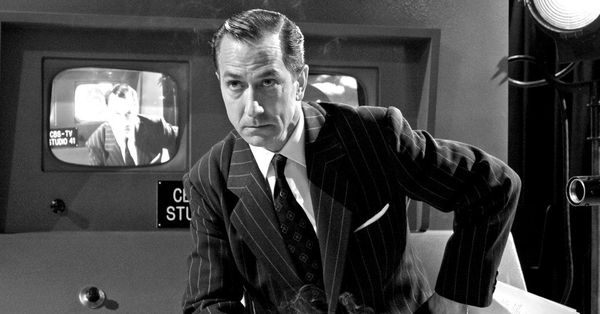Eye For Film >> Movies >> Good Night, And Good Luck (2005) Film Review

His father was a television news anchor and his own career as an actor began on the small screen, so it seems fitting that George Clooney should turn his attentions as a director to the medium that made his name. He debuted behind the cameras with Confessions Of A Dangerous Mind (2002), chronicling the life, both real and imagined, of Sixties/Seventies TV reality game show creator Chuck Barris.
In his second film, Good Night, And Good Luck, Clooney goes back even further to the early Fifties, when television was still in its infancy and only just beginning to test its twin powers to inform and entertain, and in the film's stark, literally black-and-white world, there seems to be no happy medium in which both powers can coexist.

Good Night, And Good Luck dramatises the 1953 on-air showdown between pioneering broadcast journalist Ed Murrow and Senator Joseph McCarthy, chairman of the House Un-American Activities Committee. As McCarthy exploits Cold War fears to erode civil liberties during his anti-communist witch hunts, Murrow (David Strathairn), his producer Fred Friendly (Clooney) and their dedicated team of reporters, decide to use their news documentary programme, See It Now, to break the prevailing media silence and expose McCarthy's scare mongering tactics for all to see, even if it risks antagonising CBS's sponsors and even shutting the network down. Supported, if somewhat reluctantly, by CBS boss William Paley (Frank Langella), Murrow turns McCarthy's own words against him and then offers the politician airtime to respond.
The film may be set largely within the claustrophobic confines of a television studio, where even the jazz soundtrack is composed entirely of songs performed by the studio's in-house chanteuse, but the issues that it addresses, from civil rights to the politics of fear to the role of the media in a free society are of national, even international, importance. And while its events may have unfolded over half a century ago, they resonate with surprising urgency in post-9/11 United States. Abstract away from its particulars and this is a film about the Patriot Act, Guantanamo Bay, the War On Terror and the spineless inanity of today's commercialised mass media.
In choosing to air such potentially incendiary material, with its implicit attack on contemporary Republican policies and the dumbed-down TV networks, Clooney and his cast and crew are self-consciously following in the tradition established by Murrow himself. Accordingly Clooney, like Murrow, incorporates footage of the real McCarthy to illustrate the politician's crooked modus operandi. Much as Murrow and Friendly paid the advertising costs for a controversial programme out of their own pockets when sponsors pulled out, Clooney used his own house as collateral to underwrite the production when a financing problem emerged.
The film's elegant monochrome is more than a mere badge of period authenticity. Visually it encodes a refusal to pander to the demands of populism. These days, films made without colour (Pi, The Man Who Wasn't There, 13 Tzameti) belong to a niche arthouse market that garners far more critical respectability than box office recognition and so the decision to adopt this format seems designed to ape Murrow's own reluctance to make concessions to his viewers, which feeds into one of Clooney's central themes.
Murrow stands for a type of journalism that seeks to edify, without further need to entertain. Indeed, when interviewing celebrities, such as Liberace, on the chat show, Person To Person, Murrow (brilliantly portrayed by Strathairn) looks demoralised, physically uncomfortable and literally lost for words, while his reporting on political matters shows an intelligence, articulacy and gravitas that is rarely seen on US networks today.
Good Night, And Good Luck proves that it is still possible in the cinema, if not in television, to inform without being boring and entertain without condescending. This is a serious and topical film for adults, impeccably performed and stimulating from start to finish.
Reviewed on: 15 Feb 2006




















